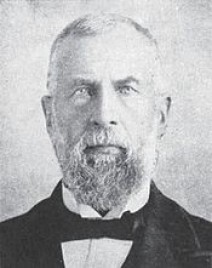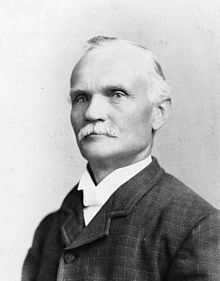William Budge

William Budge was a convert to the Church in Scotland, local missionary in the British Mission and on the continent for nine years, pioneer of Utah, and president of Bear Lake Stake for twenty-nine years.
William Budge was born in Lanark, Scotland, on May 1, 1828, the son of William and Mary Scott Budge. The boy acquired an elementary education in the common schools of Scotland. His father moved from town to town as he was required to do in his business as a salesman. In 1844, while living in Glasgow, young William Budge, sixteen years of age, overheard a man on the street as he read an account in a newspaper of the death of the Mormon Prophet Joseph Smith.
This was the first time that William ever heard the word Mormon. Four years later he was invited by a friend to attend a religious service of the Church held in Glasgow. He went out of curiosity, but the doctrines he heard greatly impressed him. He continued to attend and on the last day of the year, 1848, was baptized in the River Clyde by Elder John McMillan.
In 1851, when William was twenty-three years of age, he was ordained an elder and called to labor in the British Mission “without purse or scrip.” This was a rather severe experience for him, and he frequently went without food, but his Scotch thrift and grit stood him well in hand, and he did not falter.
For three years he traveled and preached throughout England, and then, in August, 1854, he was transferred to the Swiss and Italian Mission with headquarters at Geneva. Here he labored seven months, and succeeded in acquiring a considerable knowledge of the language, when he was imprisoned and expelled for preaching the Mormon doctrines. He returned to England, but a few weeks later was sent to Dresden, Germany, to answer an inquiry made by an investigator named Karl G. Maeser.

Karl G. Maeser later paid this compliment to Elder Budge: “It was providential that such a man was the first Mormon I ever beheld, for, although scarcely able to make himself understood in German, he, by his winning and yet dignified personality, created an impression upon me and my family which was the keynote to an indispensable influence which hallowed the principles he advocated.”
After the conversion and baptism of Professor Maeser, Elder Budge returned to England, where in July, 1856, he was appointed president of the London Conference. While laboring in this capacity he obtained the permission of the mission president, Orson Pratt, to marry Miss Julia Stratford. She was his faithful companion for fifty-six years.
William Budge was released from his missionary labors in the spring of 1860, and at once made preparations to sail for America. With his wife and a group of Saints he boarded a sailing vessel at Liverpool on May 10, and six weeks later arrived in New York City.
He then traveled by train to Omaha, and from there by ox team to Salt Lake Valley, arriving on October 5.
The problem before Elder Budge now was to make a living in Utah. He promptly moved to Farmington and obtained possession of eight acres of land and a log house. He went to work, and in a short time, obtained the necessities of life.
In 1864 President Brigham Young visited Farmington. He requested William Budge to move to Cache Valley and act as bishop of Providence. William complied with this request, sold his holdings and promptly moved to Cache Valley. At Providence he found about forty families. He labored with them and during the time he was bishop many improvements were made, including a rock meetinghouse, which still stands.
In addition to his duties as bishop, while residing in Providence, he took an active interest in public affairs. In November, 1864, he received his citizenship papers, and a few months later was appointed postmaster of the village.
At a conference held in Logan in June, 1870, President Brigham Young called Bishop William Budge to the stand and asked him if he would be willing to move to Bear Lake Valley and take charge of the collection of tithing in the settlements of the Saints in that vicinity. Elder Budge replied that he would accept the call. President Young then requested him to move to the new location as soon as he could conveniently arrange his affairs. In a few days Bishop Budge received a letter informing him of his duties and stating that his title would be “Presiding Bishop of Rich County.”
In July the bishop moved to Bear Lake and established a home at Paris. He found on arrival that his district was much more extensive than he had anticipated. It covered the growing settlements of the Saints from Soda Springs to Evanston and north to the border of Star Valley. It took several weeks to visit the various branches and wards, traveling with a horse and buggy.
After laboring seven years as “Presiding Bishop,” during which time he did excellent service for the Church, Bishop Budge was called to be the president of the Bear Lake Stake. This was in August, 1877, the year and month in which President Brigham Young died.
The northern settlements were growing; with the opening of Star Valley there were thirty-two wards and branches in Bear Lake Stake.
After he had labored less than one year as president of Bear Lake Stake, President Budge was no doubt surprised to receive a letter in May, 1878, calling him to be the president of the European Mission with headquarters at Liverpool, England. He responded readily to this call. He was a natural missionary and was fond of missionary work. He was not released as president of Bear Lake Stake; he left that work in the hands of his counselors and proceeded to Liverpool.
After laboring diligently for two and a half years, during which time he visited the branches of the Church in the British Isles and on the continent, President Budge was released to return home. Among the elders who had labored with him in the Liverpool office were Charles W. Nibley, Frank Cope, Henry H. Rolapp, and James H. Wallis.
William Budge was elected to the Idaho Legislature while still in England, and it was therefore necessary for him to proceed at once to Boise. From his home in Paris he went by stage to Evanston, thence by train to Kelton, Box Elder County, and then by stage across southern Idaho to the capital city. It was a long, hard journey.
After his service in the Legislature, President Budge returned to his work in the Bear Lake Stake. However, during the summer of 1881 he performed another public service; he assisted the Union Pacific Railroad in acquiring a right of way from Evanston through Bear Lake Valley.
In 1884, under the direction of President Budge, the building of a stake tabernacle was begun at Paris. It took five years of diligent and unselfish labor to complete the building, but it still stands, an honor and credit to the pioneer people by whom it was constructed.
Gradually President Budge became one of the prominent men of Idaho. In October, 1888, and again in January, 1890, he journeyed to Washington, D. C., to interview officials of the government and secure their aid in behalf of the Mormon people in the Territory, who were subject to unjust laws and regulations. Again in 1904 he testified before the Senate Committee on Privileges and Elections in the Reed Smoot hearing, whose seat in the Senate was contested because of his being an official of the Church.
After residing in Paris thirty-six years, President Budge was appointed in 1906, at the age of 78, to be the president of the Logan Temple. He found this work to be very pleasant, and in Logan he was surrounded by a number of his children who had established themselves in the temple city, which added to his happiness.
President William Budge died at Logan on March 18, 1919, at the age of 90, honored, respected and loved by all who knew him.
Notes
Preston Nibley, Stalwarts of Mormonism, p. 10-14. See also: Purpose Driven Motherhood for a great write up on William Budge, as well as photos of his grave site, and The Life of William Budge by his daughter Alta Budge Kidman.

Thank you for this wonderful summary of my grandpa William Budge! My son is going to play his part on our pioneer trek soon, and your summary will help him connect with his grandpa. And thank you for linking to my blog post about him, Purpose Driven Motherhood. As a fellow blogger, I applaud your work to use social media to spread light and goodness!
– Becky Edwards
Thanks Becky, and thanks for checking out this site! Any way we can spread the truth, right? Carry on!
Thank you for this wonderful summary of my grandpa William Budge! My son is going to play his part on our pioneer trek soon, and your summary will help him connect with his grandpa. And thank you for linking to my blog post about him, Purpose Driven Motherhood. As a fellow blogger, I applaud your work to use social media to spread light and goodness!
– Becky Edwards